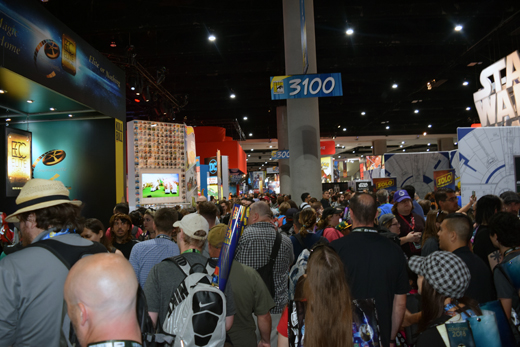
By Donald H. Harrison

SAN DIEGO — Miriam Libicki, a Comic-Con veteran of more than a dozen years, says even though the annual convention “is so huge and corporate,” she keeps coming back because “there are many smaller cons inside comic con.” In a section of the main exhibit hall that is reserved for self-published comic book artists and authors, known collectively as the Small Press, “It’s like going to summer camp; you get to see all your friends. It’s a community.”
Having written a feature story about Libicki at last year’s Comic Con, I knew what she meant. My own interest is Jewish stories, which in the rest of the mammoth exhibition hall, are typified by images of Star Trek’s Kirk and Spock (who had been portrayed by Jewish actors William Shatner and Leonard Nimoy), Wonder Woman (played by Israeli actress Gal Gadot), and that kid with the Hebrew sounding name, Kal-El, who came from the planet Krypton and grew up to be Superman. But newer, non-franchise material, even some with Jewish stories, can be found in the Small Press area, so that was where I headed on Wednesday night, July 18, a night that Comic-Con calls “preview night.”
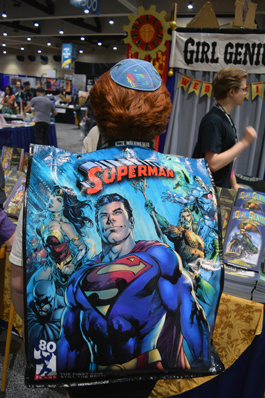
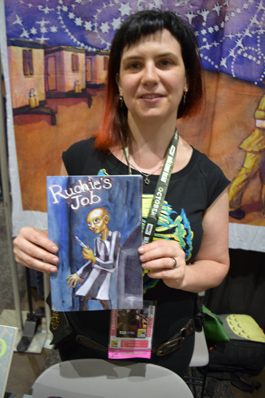
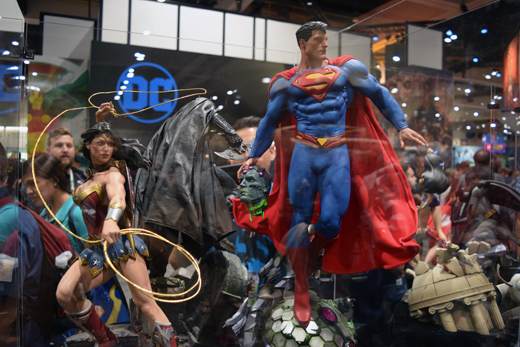
There were so many thousands of fans “previewing” the exhibition hall, I had to think that if any small convention attracted such attendance, its organizers would have happily closed up when the evening was done and counted the profits. Comic-Con, on the other hand, was just getting started. Still to go were four full days on Thursday, Friday, Saturday, and Sunday before it would pack up. Comic-Con has proven such a popular San Diego attraction, that is planning to have permanent exhibitions along with programming in one of the museum buildings of Balboa Park. When it opens, date still uncertain, its nearest museum neighbors will be the Air & Space Museum, the Automobile Museum, a puppet theatre, and the collection of national cottages, Israel’s included, known collectively as the House of Pacific Relations. “Pacific” in this instance refers to “peaceful” not to the nearby ocean.
In our interview last year, Libicki and I had discussed her graphic novel Jobnik, based on her experiences as a soldier in the Israel Defense Forces. She had been tucked away at a base in the Negev, essentially doing make work. This year, Libicki brought out a much thinner comic book called Ruchie’s Job, which is a Holocaust survival story based on the experiences of the great-aunt of her friend, Dr. Dana Kotler.
The story begins with two sisters, aged approximately 16 and 12, arriving at Auschwitz and being separated into two lines. Somehow, Ruchie, the older sister, knew that the other line meant death, so she created a distraction to get her sister, Rifka, to switch lines. Seeing the young girl was in panic, Ruchie teased her younger sibling about her posture, getting her to stand up straighter and to look taller. Eventually, the sisters were assigned to kitchen duty together, a position that enabled them to smuggle extra food to other inmates of the death camp. The third scenario shows what happened on the day of liberation.
Because the two sisters joke with each other, Libicki says she worries how Ruchie’s Job will be received. She, herself, is the granddaughter of a Holocaust survivors, and knows that for many people, there is absolutely nothing humorous about the Holocaust. However, she says, humor was what kept the two sisters’ spirits up, increasing their will to live.
It should be noted, nevertheless, that Ruchie’s Job is mostly fictional, in that Libicki had to imagine many of the details fleshing out her friend’s family story.
Although she was familiar with the story for a long time, Libicki hadn’t done anything with it until she took a creative writing class in pursuit of her Master of Fine Arts (MFA) at the University of British Columbia. In that class, her assignment was to come up with a 14-page screen play, and she decided her friend’s family experience would lend itself well to such a treatment. Following the class, she began work on her thesis, which she describes as a 200-page graphic novel “of which I have drawn almost none of it, and I was itching – after all that preparing and writing for something that might be years down the line, I really just wanted to write a comic, write something, and draw something, and put it out there.” So, using her short movie script as a guide, she developed Ruchie’s Job.
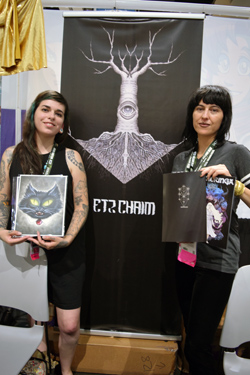
In another row of Small Press exhibitors, I looked for a company called Etz Chaim, which I had imagined might be a Jewish concern, perhaps devoted to rendering stories from the Torah (our Jewish “tree of life”) in graphic art. On arrival at the booth, however, I found two young ladies from Santa Fe, New Mexico, who were not Jewish. Stephanie Alia identifies as a Wiccan, whereas Lindsay Payton describes herself as a “spiritualist.”
This was the first Comic-Con for the two friends, and their excitement was palpable. “Santa Fe is an art town but it is different from what we do,” said Payton. “This is like the Mecca of all great nerds. Everyone likes the same thing; so it is really exciting to be here.”
Both are captivated by the concept of a Tree of Life, which Alia described as symbolizing “enlightenment.” A poster behind them bore an illustration of what a “Tree of Life” might look like. Alia, a writer who commissions different artists to assist in her story telling, told me that her Etz Chaim symbol appears in almost every work that she does, and that she even has a “Tree of Life” tattoo on her body. It was not in plain sight.
When she was a young girl of elementary school age, Alia said, she had a dream about a “tree of life.” Later she saw some imagery of it, that she was told came from Kabbala, “so I started reading and researching it and always felt very connected to it.”
Payton said that for her the Tree of Life embodies the idea that “everything is connected: the underworld and here, as above, so below. And everything comes around.”
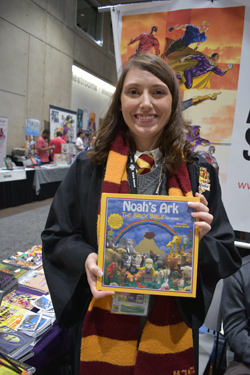
At their table was the comic book Alcheringa, Alia’s story of a young woman whose dreams about a war between dark and light forces are vivid and frightening, even though she dreams herself to be a powerful warrior for the light side.
Alcheringa, commented Alia, is about “dark fantasies, people traveling to other worlds through dreaming.” She added that there are “people who are spiritually inclined; in the waking world, they are normal, ordinary people, but in the spiritual world, they are warriors, and they have to look for (and protect) universal balance.”
Payton, an artist, likes to focus on “borders and stuff, symbolism, what do plants mean, playing a record backwards, paying the ferryman with coins – interesting things like that.” Payton is covered with numerous tattoos, including a Jersey devil, a werewolf, a woman in white, and, she confided, she has a “whole chest piece for Hans Christian Anderson,” based on his character, The Snow Queen. Although the tattoos come from diverse sources, “it all comes together somehow,” she said.
A row or two away, volunteer Helen Frederick from Los Angeles staffed a much different kind of booth featuring Christian comics. In addition to various New Testament stories, there were comic book versions of the Tanach‘s stories of Noah, Joshua, Hannah, Ruth, and Daniel. Some were captioned in Spanish, others in English. It was clear that Frederick was not only an exhibitor, but a fan. She wore the robe and scarf of a Hogwarts student from the Harry Potter series of books and movies.
*
Harrison is editor of San Diego Jewish World. He may be contacted via donald.harrison@sdjewishworld.com
Pingback: Survivor Ruth G. Sax impresses Comic- Con audience | San Diego Jewish World